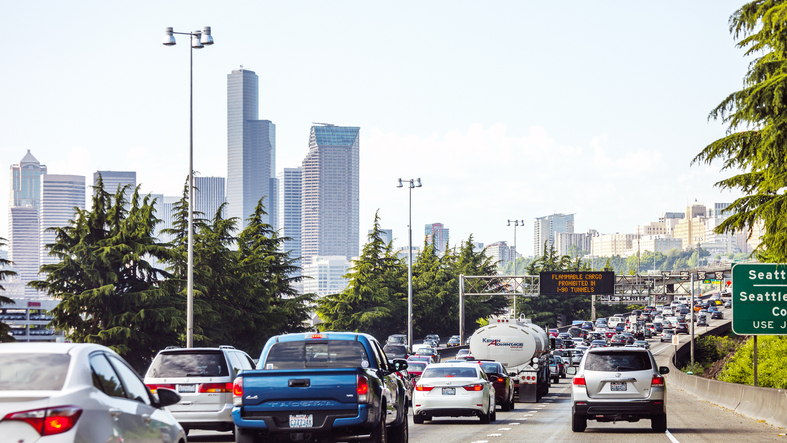Articles
Find a doable post-pandemic commute
July 11, 2022
by PEMCO Insurance
How to find a doable post-pandemic commute
A post-pandemic return to the office has many workers rethinking their commute and redefining what’s sustainable. The question is bigger than it used to be. People must factor their COVID risk tolerance (Am I comfortable sharing air space with people on a bus or train?) and work-life balance, with many of us having adapted to a commute-free workstyle over the past two years.
Here’s how the experts say our commutes have changed, where they might be headed and the hidden toll a return to pre-pandemic habits may take on our health. (Spoiler: Shorter commutes are better – way better – for your wellbeing than that extra bedroom, bigger yard or slightly higher salary that may be tempting you. And shorter distances may mean you save money on your insurance, too!)
How has commuting changed in urban areas?
Hybrid workstyles appear to be holding urban commutes to about 70% of pre-pandemic levels in some cities (Seattle included), with just 33% of workers reporting to their desks three or more days a week, according to INRIX traffic studies released in May. Fewer in-person workers hasn’t necessarily translated to fewer cars on the road during commute times (although the overall length of rush hour has likely shortened). That’s because many downtown hybrid workers appear to be driving rather than using mass transit on their office days. Greater workhour flexibility also has fueled higher traffic volumes at all times of day.Nielsen data collected last fall shows that commutes declined among people who traveled more than 20 minutes a day, with the greatest declines among 30- to 59-minute commuters. Probably not coincidentally, that’s a demographic weighted toward people with administrative jobs for whom telework was and may continue to be an option.
An interagency study team, including researchers from the University of Washington and King County Metro, suggests it may take five to 10 years before Seattle commutes return to their pre-pandemic normal.
How does commuting affect health?
None of us seems to like commuting very much. The Harvard Business Review reported a study in which the morning commute ranked as the No. 1 worst part of respondents’ days, the evening commute ranked No. 3 and the workday itself was No. 2.The Review also reported a separate UK survey that found people with lengthy commutes reported feeling more anxious and less satisfied with their lives, while a Swedish study went so far as to quantify it, finding couples had a 40% greater chance of divorce when one partner commutes as least 45 minutes to work a day.
Longer commutes impact our wellbeing four ways:
1. Opportunity costs. All that driving means less time for seeing family and friends, participating in community events, exercising, sleeping, and cooking (presumably healthier meals) at home, according to Smart Asset, a financial guide and calculator site.
2. Physical and financial strain. Hours spent strapped in behind the wheel contribute to increased back and neck pain. Financial strain mounts, too, with more money spent on gas and car maintenance.
3. Psychological stress. Commuting by car is unpredictable and isolating. We can’t control traffic and weather delays, and drive time is usually spent without social interaction. Bus and train riders face different stressors although at least for train riders, traffic variations usually aren’t an issue once they arrive at the station for boarding.
4. Job burnout. People dramatically underestimate the quality-of-life tradeoff between salary and commute times, according to Convene, a provider of meeting, event and flexible workspace. It reports a UK study that showed adding 20 minutes to a daily commute has the same negative impact on job satisfaction as taking a 19% pay cut. Yet when asked to choose between a hypothetical job that paid $67,000 a year with a 50-minute commute or a job that paid $64,000 with a 20-minute commute, 84% of survey respondents picked the higher salary. The math comes out to sacrificing one extra hour a day to commuting, 250 hours a year, for $12 an hour – some of which must go to cover added gasoline, car maintenance, childcare and takeout food expense.
How can I make my commute better?
Think big picture. If you’re looking to gain unique experience or improve your long-term prospects for earning a higher salary or prized position, then gritting your teeth through a long commute may be a worthwhile means to an end. So would driving extra distance for a job you truly love. But deciding between two mostly equal choices? Opt for the shorter commute.Reframe how you think about commuting. If you’re traveling alone by car, make it a time to do something for yourself. That might be listening to audio books or practicing foreign language skills for your dream vacation. If you’re riding a bus or train, could you use the time to sketch, knit or write a note to an elderly relative? (Skip the phone scrolling unless you truly feel joy and accomplishment in doing it.)
Adopt a pleasant ritual. Give yourself something to look forward to, whether it’s swinging by a favorite coffee stand before you hit the freeway or choosing a back route on the way home to take in something beautiful – a field of grazing horses, a water view or a canopy of trees.
Ask your employer for flexibility. That might mean shifting your in-office start time to avoid the worst of the traffic. The commute-length sweet spot seems to be about 20 minutes, with stress starting to build significantly after 35 minutes.
Can a shorter commute affect my insurance?
Yes! Many factors determine the rate you pay for insurance. One of them is your annual mileage. If you’re commuting less than you did pre-pandemic, we may be able to reduce your rates. Go online, talk to your local PEMCO agent or call 1-800-GO-PEMCO to find out.Share on social media